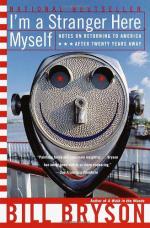
|
| Name: _________________________ | Period: ___________________ |
This test consists of 5 short answer questions, 10 short essay questions, and 1 (of 3) essay topics.
Short Answer Questions
1. Which American tourist attraction does Bryson describe as a "Total Indoor Environment"?
2. In "Enough Already," which item comes in 18 varieties in American supermarkets?
3. What does Bryson hate about Christmas?
4. What do the British celebrate on December 26th?
5. Why does Bryson have to buy a whole new computer and fax system when he returns to the United States?
Short Essay Questions
1. "Your Tax Form Explained", what does Bryson satirize? Give three examples of how he does this.
2. In "A Day at the Seaside," what does Mrs. Bryson suggest the family do? How does Bill react to this?
3. Bryson explains the joys of living in a snowy climate in "Fun in the Snow." How does he give the reader the impression that he is not a natural athlete?
4. In "Life's Mysteries," Bryson lists a very large number of things that he doesn't understand. What are four of these things?
5. In "Ah, Summer!" what does Bryson say he likes about summers in New Hampshire? How does he compare them to summers in Iowa?
6. "Book Tours", Bryson talks about his fondness for book tours. Why does he like them?
7. In "The Flying Nightmare," Bryson compares modern air travel with air travel from his youth in the 1960s and 70s. List three points he makes.
8. In "The Wasteland," what is Bryson criticizing? Name three points of his criticism.
9. "The Myteries of Christmas" compares American Christmases and English Christmases. How does Bryson compare the two holidays?
10. In "Enough Already," Bryson says there is just too much of everything in America (except time, money, good plumbers, and polite people). What examples does he give to back this up? Why does he think it is not a good thing?
Essay Topics
Write an essay for ONE of the following topics:
Essay Topic 1
"I'm a Stranger Here Myself" is a first person narrative, told from Bill Bryson's point-of-view. Briefly explain how the first person narrative is effective and how it is limited. Give four specific examples that show how the memoir is effectively told from Bill Bryson's point of view. How is our vicarious experience enhanced by Bryson's choice of first person?
Essay Topic 2
Define memoir as a literary genre. What elements of the memoir are found in "I'm a Stranger Here Myself"? Briefly outline the main points of Bill Bryson's experiences as they are described in the book. Discuss why you believe they are appropriate or not as inclusions in a memoir about a man returning to his country of birth after twenty years away.
Essay Topic 3
Tone refers to the attitude of the narrator in a work. As the narrator of "I'm a Stranger Here Myself," what is the author's tone at different stages of the book? Explain the tone by using examples from the following events:
1) When Bryson first returns to America.
2) When he is frustrated with some of the challenges he faces in America.
3) When his son goes off to college.
4) When he is celebrating holidays in the United States.
|
This section contains 1,407 words (approx. 5 pages at 300 words per page) |

|




